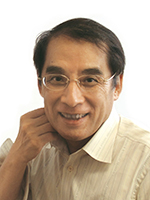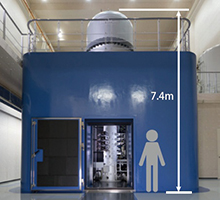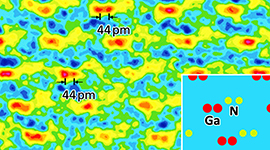Funding Program for World-Leading Innovative R&D on Science and Technology (FIRST Program)
http://www.jst.go.jp/first/english/

The core researcher
Dr. Akira TONOMURA (deceased)
Holography is the art or process of making a hologram using a laser. A laser can be replaced with electron beams for generating interference patterns (hologram) using the wave nature of electrons. Holography using electron beams allows the observation of magnetic and electric fields, which are invisible to standard electron microscopes. As characterized by the shorter wavelengths compared to visible light, electron beams enable atomic-level observation that is impossible through optical microscopes. An electron holography microscope is an instrument with which to measure microscopic magnetic and electric fields.
A research project was headed by the late core researcher Dr. Akira TONOMURA, a pioneer in electron holography microscopes (the acting core researcher is Dr. Nobuyuki OSAKABE) at the central research laboratory of Hitachi, Ltd. A new electron holography microscope developed in the project realized the world’s best resolution of 43 picometers.*
*One pico is one trillionth.
The main feature of this microscope is the world’s first installation of a spherical-aberration corrector in an ultra-high-voltage electron microscope. Correcting aberration in lens performance has been a challenge since the development of electron microscopes and also is the key to improving the resolution. In this project, a highly stable electron beam of 1.2 megaelectronvolts* and the spherical aberration corrector have been combined.
*One mega is one million.
This achievement is the fruit of the courageous and relentless efforts of researchers based on the tradition of electron microscopes for which Japan is known as a world leader.
In the microscope image of a crystalline gallium nitride (GaN), a material in blue LEDs, by using this microscope, we could observe separate gallium atoms at 44 picometer intervals. Because of the high resolution and the capability to observe electromagnetic fields, we expect to use the electron holography microscope to measure microscopic magnetic fields in developing high-performance magnetic devices and so on. We also hope that the microscope will help in the development of basic science for opening up cutting-edge materials science and the quantum world.
*JST has been designated the institution that provides support for the aforementioned research in the FIRST program of the Cabinet Office, government of Japan.
- - This is an English translation of NEWS 1 in TOPICS, which was published in the April 2015 issue of JST news.
http://www.jst.go.jp/pr/jst-news/pdf/2015/2015_04_p16.pdf

The front of the electron holography microscope developed in the project

Gallium atoms (in red) can be observed at 44 picometer intervals. (The image in the lower right shows atomic models.)
JST, an integrated organization of science and technology in Japan, establishes an infrastructure for the entire process from the creation of knowledge to the return to the society. For more information, visit http://www.jst.go.jp/EN/